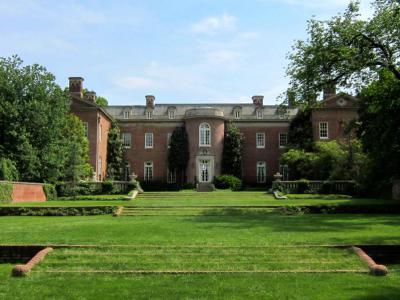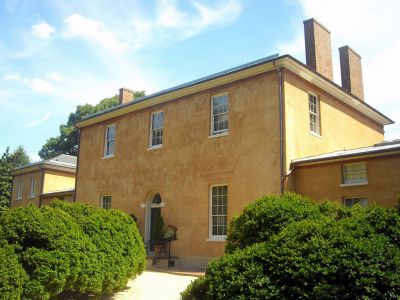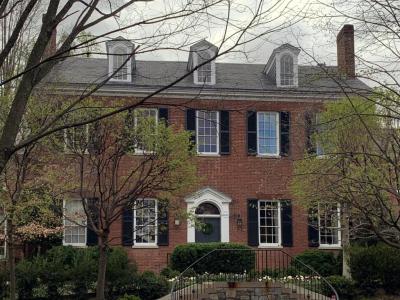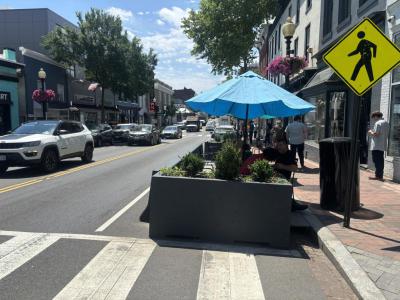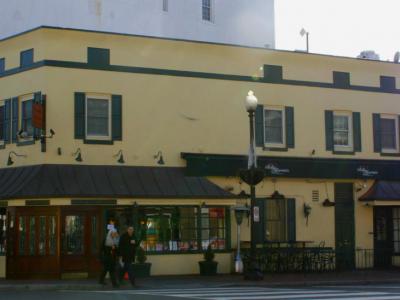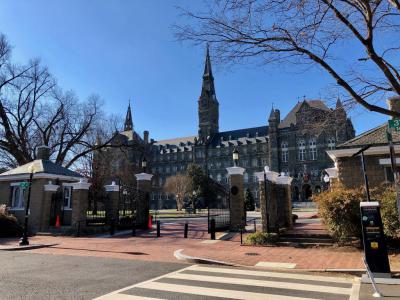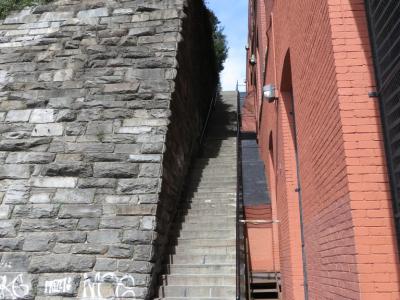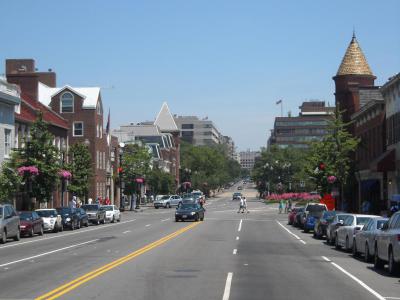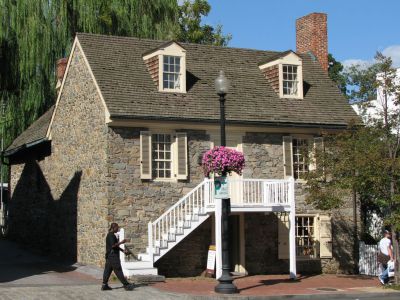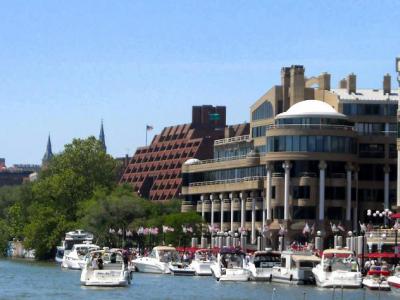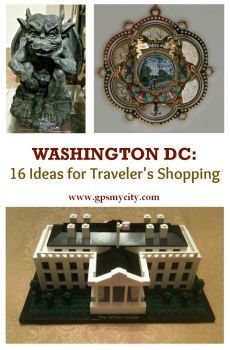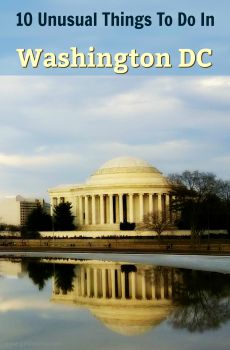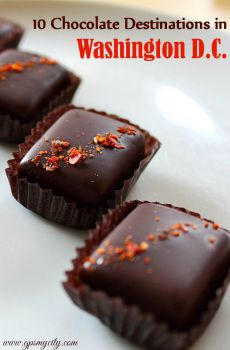Georgetown Walking Tour (Self Guided), Washington D.C.
Georgetown is a historic neighborhood situated in the northwest quadrant of Washington, DC. Despite its proximity to downtown, this former port area has preserved much of its distinct character. In Georgetown, "old-world charm meets modern allure," they say. Those poetically inclined tend to compare it to "a tapestry of cobblestone dreams and timeless grace."
The neighborhood is anchored by iconic landmarks such as Dumbarton Oaks and Tudor Place, reflecting a blend of colonial-era architecture and modern vibrancy. Dumbarton Oaks – renowned for its museum and gardens – offers a tranquil retreat amid its meticulously landscaped grounds, while the nearby Tudor Place, a grand Federal-style mansion, showcases American history through its elegant rooms and expansive gardens.
The Bowie-Sevier House, another architectural gem, stands as a testament to Georgetown's past. Meanwhile, Wisconsin Avenue serves as the area's bustling thoroughfare, lined with shops, cafes, and historic buildings. Martin's Tavern, a local institution since 1933, is famed for its cozy atmosphere and a host of notable figures, including former US president John Kennedy, who dined there over the decades.
Georgetown University, a prominent academic institution, enriches the neighborhood with its collegiate ambiance and Gothic-style buildings. Holy Trinity Catholic Church, a cornerstone of the community since the 18th century, stands as a beacon of faith and history. Not far off, the Exorcist Steps, famous for being the film site of the iconic horror movie, offer a glimpse into the neighborhood's cinematic ties.
M Street, Georgetown's lively commercial hub, brims with upscale boutiques, restaurants, and nightlife venues. In turn, the Old Stone House, dating back to 1765, is the oldest structure in Washington, DC.
Finally, overlooking the Potomac River, Washington Harbour is a waterfront complex that is renowned for its outdoor seating and lively vibe. Its stunning views and dining options make it a popular destination year-round.
In Georgetown, “the streets whisper tales of the past, while the present dances with sophistication.” If you want to hear some of these tales yourself and feel Georgetown's intoxicating blend of heritage and contemporary chic, embark on this self-guided walking tour.
The neighborhood is anchored by iconic landmarks such as Dumbarton Oaks and Tudor Place, reflecting a blend of colonial-era architecture and modern vibrancy. Dumbarton Oaks – renowned for its museum and gardens – offers a tranquil retreat amid its meticulously landscaped grounds, while the nearby Tudor Place, a grand Federal-style mansion, showcases American history through its elegant rooms and expansive gardens.
The Bowie-Sevier House, another architectural gem, stands as a testament to Georgetown's past. Meanwhile, Wisconsin Avenue serves as the area's bustling thoroughfare, lined with shops, cafes, and historic buildings. Martin's Tavern, a local institution since 1933, is famed for its cozy atmosphere and a host of notable figures, including former US president John Kennedy, who dined there over the decades.
Georgetown University, a prominent academic institution, enriches the neighborhood with its collegiate ambiance and Gothic-style buildings. Holy Trinity Catholic Church, a cornerstone of the community since the 18th century, stands as a beacon of faith and history. Not far off, the Exorcist Steps, famous for being the film site of the iconic horror movie, offer a glimpse into the neighborhood's cinematic ties.
M Street, Georgetown's lively commercial hub, brims with upscale boutiques, restaurants, and nightlife venues. In turn, the Old Stone House, dating back to 1765, is the oldest structure in Washington, DC.
Finally, overlooking the Potomac River, Washington Harbour is a waterfront complex that is renowned for its outdoor seating and lively vibe. Its stunning views and dining options make it a popular destination year-round.
In Georgetown, “the streets whisper tales of the past, while the present dances with sophistication.” If you want to hear some of these tales yourself and feel Georgetown's intoxicating blend of heritage and contemporary chic, embark on this self-guided walking tour.
How it works: Download the app "GPSmyCity: Walks in 1K+ Cities" from Apple App Store or Google Play Store to your mobile phone or tablet. The app turns your mobile device into a personal tour guide and its built-in GPS navigation functions guide you from one tour stop to next. The app works offline, so no data plan is needed when traveling abroad.
Georgetown Walking Tour Map
Guide Name: Georgetown Walking Tour
Guide Location: USA » Washington D.C. (See other walking tours in Washington D.C.)
Guide Type: Self-guided Walking Tour (Sightseeing)
# of Attractions: 11
Tour Duration: 2 Hour(s)
Travel Distance: 3.9 Km or 2.4 Miles
Author: DanaOffice
Sight(s) Featured in This Guide:
Guide Location: USA » Washington D.C. (See other walking tours in Washington D.C.)
Guide Type: Self-guided Walking Tour (Sightseeing)
# of Attractions: 11
Tour Duration: 2 Hour(s)
Travel Distance: 3.9 Km or 2.4 Miles
Author: DanaOffice
Sight(s) Featured in This Guide:
- Dumbarton Oaks
- Tudor Place
- Bowie-Sevier House
- Wisconsin Avenue
- Martin's Tavern
- Georgetown University
- Holy Trinity Catholic Church
- Exorcist Steps
- M Street
- Old Stone House
- Washington Harbour
1) Dumbarton Oaks
Perched atop the historic Georgetown neighborhood, Dumbarton Oaks stands as a must-visit destination within Washington, D.C. This sprawling 53-acre property is the enduring legacy of philanthropists and art enthusiasts Robert Woods Bliss and his wife Mildred.
In the year 1920, following an extensive and meticulous search, the Bliss couple acquired an old-fashioned Federal-style country house nestled amidst somewhat neglected grounds. By 1929, they expanded the estate by adding a Music Room, and in subsequent years, constructed a wing to house their renowned collection of Byzantine art. Another wing was subsequently built to showcase Mr. Bliss's assemblage of Pre-Columbian art.
In 1921, the Blisses enlisted the talents of renowned landscape designer Beatrix Farrand to craft an English garden enveloping the entire property. Over nearly three decades of close collaboration, Mildred Bliss and Beatrix Farrand meticulously planned every aspect of the gardens, including terraces, benches, urns, and borders, ultimately fashioning a stunning urban oasis.
By 1940, the upper sixteen acres of the estate were bequeathed to Harvard University for the establishment of a research institute dedicated to Byzantine studies, Pre-Columbian studies, as well as the history of gardens and landscape architecture. Concurrently, a Garden Library was established to house Mrs. Bliss's collection of rare books chronicling the history of gardens.
Presently, the entire estate operates under the auspices of Harvard University's Trustees. Its impressive art collection has been on extended loan to the National Gallery of Art.
Why You Should Visit:
The Museum is home to a world-class collection of Byzantine and Pre-Columbian art; the old music and rare books rooms are fascinating to walk through. From the tapestries and paintings in the Renaissance-inspired Music Room to the graceful lines and natural sunlight of the Philip Johnson Pavilion, visitors can admire art dating back to antiquity, as well as innovative special exhibitions.
You can easily spend a few hours wandering through the gardens and discovering every hidden corner.
Everything is well-kept up – space, lighting, staff, historical rooms, terraces, gardens, and security.
Tip:
Make sure you get the booklet and follow the suggested garden route as it helps to understand the layout. Also look out for birds and small mammals.
In the year 1920, following an extensive and meticulous search, the Bliss couple acquired an old-fashioned Federal-style country house nestled amidst somewhat neglected grounds. By 1929, they expanded the estate by adding a Music Room, and in subsequent years, constructed a wing to house their renowned collection of Byzantine art. Another wing was subsequently built to showcase Mr. Bliss's assemblage of Pre-Columbian art.
In 1921, the Blisses enlisted the talents of renowned landscape designer Beatrix Farrand to craft an English garden enveloping the entire property. Over nearly three decades of close collaboration, Mildred Bliss and Beatrix Farrand meticulously planned every aspect of the gardens, including terraces, benches, urns, and borders, ultimately fashioning a stunning urban oasis.
By 1940, the upper sixteen acres of the estate were bequeathed to Harvard University for the establishment of a research institute dedicated to Byzantine studies, Pre-Columbian studies, as well as the history of gardens and landscape architecture. Concurrently, a Garden Library was established to house Mrs. Bliss's collection of rare books chronicling the history of gardens.
Presently, the entire estate operates under the auspices of Harvard University's Trustees. Its impressive art collection has been on extended loan to the National Gallery of Art.
Why You Should Visit:
The Museum is home to a world-class collection of Byzantine and Pre-Columbian art; the old music and rare books rooms are fascinating to walk through. From the tapestries and paintings in the Renaissance-inspired Music Room to the graceful lines and natural sunlight of the Philip Johnson Pavilion, visitors can admire art dating back to antiquity, as well as innovative special exhibitions.
You can easily spend a few hours wandering through the gardens and discovering every hidden corner.
Everything is well-kept up – space, lighting, staff, historical rooms, terraces, gardens, and security.
Tip:
Make sure you get the booklet and follow the suggested garden route as it helps to understand the layout. Also look out for birds and small mammals.
2) Tudor Place
Tudor Place stands as one of the prominent mansions from the Federal era in the United States. It was designed by William Thornton, the architect responsible for the U.S. Capitol. Construction of the house commenced around 1794 and concluded approximately in 1815.
The house was owned by Thomas Peter and his wife, Martha Parke Custis Peter, who had significant ties to the Washington, Custis, and Lee families. Thomas Peter served as the mayor of Georgetown from 1789 to 1798, and Martha Parke Custis was the granddaughter of Martha Washington. After Mrs. Washington's passing, the Peter family inherited a considerable number of enslaved individuals from Mount Vernon. They continued to hold these individuals in bondage for many years, and some were only freed as a result of the Civil War.
The house is situated atop a hill within an extensive estate featuring lawns and gardens. While the north-facing side of the structure is notably unadorned, the south-facing elevation, which overlooks Georgetown, is a striking example of Regency design. The main house comprises end pavilions connected by loggias, stuccoed brick facades with minimal ornamentation, and Tuscan columns. The building boasts an unconventional floor plan but boasts fine interior detailing.
A highlight of Tudor Place is its collection of over 100 items that once belonged to George and Martha Washington. Enriched by 180 years of ownership by the Peter family, both the residence and the gardens offer a unique window into American cultural and social history. In 1960, the site was designated as a National Historic Landmark and is now accessible to the public.
The house was owned by Thomas Peter and his wife, Martha Parke Custis Peter, who had significant ties to the Washington, Custis, and Lee families. Thomas Peter served as the mayor of Georgetown from 1789 to 1798, and Martha Parke Custis was the granddaughter of Martha Washington. After Mrs. Washington's passing, the Peter family inherited a considerable number of enslaved individuals from Mount Vernon. They continued to hold these individuals in bondage for many years, and some were only freed as a result of the Civil War.
The house is situated atop a hill within an extensive estate featuring lawns and gardens. While the north-facing side of the structure is notably unadorned, the south-facing elevation, which overlooks Georgetown, is a striking example of Regency design. The main house comprises end pavilions connected by loggias, stuccoed brick facades with minimal ornamentation, and Tuscan columns. The building boasts an unconventional floor plan but boasts fine interior detailing.
A highlight of Tudor Place is its collection of over 100 items that once belonged to George and Martha Washington. Enriched by 180 years of ownership by the Peter family, both the residence and the gardens offer a unique window into American cultural and social history. In 1960, the site was designated as a National Historic Landmark and is now accessible to the public.
3) Bowie-Sevier House
The Bowie-Sevier House, constructed in the early 1800s, stands as a significant example of Federal-style architecture in Georgetown. Built around 1810 by Washington Bowie, a prominent merchant, real estate speculator, church vestryman, militia officer, and one of Georgetown’s wealthiest men, the house reflects the grandeur and elegance of its era. Perched in the heights of Georgetown, the home provided Bowie and his large family with majestic views south toward the port, along with spacious rooms designed for entertaining and social gatherings.
The house, which incorporated a smaller, earlier dwelling, features a facade adorned with a harmonious blend of Adamesque and Classical Revival details, showcasing the architectural sophistication of the period. Throughout its long history, the Bowie-Sevier House was home to only four families: the Bowies, the Nicholls, the Hollingsworths, and the Seviers. Each family contributed to the house's legacy, maintaining its grandeur and historical significance through the decades.
In 1953, following the death of Mrs. Ella Sevier, the last matriarch of the Sevier family, the house transitioned to a new chapter in its history. It was bequeathed to the Episcopal Church ministry for use as a retirement home for Episcopal women, serving also as a memorial to Mrs. Sevier’s husband’s great-grandfather, General John Sevier. This new purpose allowed the house to continue to serve the community while preserving its historical essence and architectural beauty.
The house, which incorporated a smaller, earlier dwelling, features a facade adorned with a harmonious blend of Adamesque and Classical Revival details, showcasing the architectural sophistication of the period. Throughout its long history, the Bowie-Sevier House was home to only four families: the Bowies, the Nicholls, the Hollingsworths, and the Seviers. Each family contributed to the house's legacy, maintaining its grandeur and historical significance through the decades.
In 1953, following the death of Mrs. Ella Sevier, the last matriarch of the Sevier family, the house transitioned to a new chapter in its history. It was bequeathed to the Episcopal Church ministry for use as a retirement home for Episcopal women, serving also as a memorial to Mrs. Sevier’s husband’s great-grandfather, General John Sevier. This new purpose allowed the house to continue to serve the community while preserving its historical essence and architectural beauty.
4) Wisconsin Avenue
Wisconsin Avenue is a vibrant corridor known for its diverse shopping and dining experiences, stretching from the upscale neighborhood of Georgetown to the bustling areas of Tenleytown and Friendship Heights.
In Georgetown, Wisconsin Avenue intersects with M Street, creating a dynamic hub of high-end boutiques, national retailers, and unique local shops. Visitors can explore an array of fashion outlets, from the contemporary styles at Zara and Anthropologie to luxury brands like Ralph Lauren and Louis Vuitton. The avenue also hosts specialty stores, offering everything from artisanal chocolates at L.A. Burdick to exquisite stationery at Paper Source.
Dining on Wisconsin Avenue is equally impressive, offering a culinary journey that caters to all tastes and preferences. Georgetown's dining scene is particularly notable, featuring renowned establishments such as Martin's Tavern, a historic eatery where numerous U.S. Presidents have dined, and the sophisticated Italian fare at Fiola Mare, located along the scenic waterfront.
In Georgetown, Wisconsin Avenue intersects with M Street, creating a dynamic hub of high-end boutiques, national retailers, and unique local shops. Visitors can explore an array of fashion outlets, from the contemporary styles at Zara and Anthropologie to luxury brands like Ralph Lauren and Louis Vuitton. The avenue also hosts specialty stores, offering everything from artisanal chocolates at L.A. Burdick to exquisite stationery at Paper Source.
Dining on Wisconsin Avenue is equally impressive, offering a culinary journey that caters to all tastes and preferences. Georgetown's dining scene is particularly notable, featuring renowned establishments such as Martin's Tavern, a historic eatery where numerous U.S. Presidents have dined, and the sophisticated Italian fare at Fiola Mare, located along the scenic waterfront.
5) Martin's Tavern
Established in 1933, Martin's Tavern is the oldest family-owned restaurant in Washington, D.C. Situated one block north from Wisconsin Avenue, in the heart of Georgetown, the tavern was founded by former Major League Baseball player William Gloyd "Billy" Martin. Over the years it has hosted pretty much every U.S. President, from Harry S. Truman to George W. Bush.
Back in the day, Martin's Tavern seemed more like a place for the older, well established, famous, and overall somewhat stodgy people. Today, this Georgetown classic, albeit seemingly unchanged for decades, appeals to the much broader crowd, and in a rather comforting way, with its dark wooden bar, oak paneling, booths, stained glass light fixtures, paintings of old-time DC and signed retro photos. Every booth within this place has its own memories, sometimes bronze plaques, and often carved initials. Booth #3 near the door is famously where, on June 24, 1953, Senator John F. Kennedy (then 36) proposed marriage to Jaqueline Lee Bouvier (aged 24) and she said yes. The young Jack Kennedy lived just two blocks away and used to come here often, on Sundays after services.
Martin's menu is a mix of American and pub food (potato skins, fish and chips, etc.), and while it isn’t life-changing, you’ll probably get a good history lesson here while eating it. Otherwise, this place is great for people watching, especially in good weather, as there are lots of outside sidewalk tables. It is very fun and surprisingly less expensive than some of the nearby Italian joints.
Tip:
There are private back rooms under the stairs reserved for people with security issues (it is Georgetown after all, mind you).
Back in the day, Martin's Tavern seemed more like a place for the older, well established, famous, and overall somewhat stodgy people. Today, this Georgetown classic, albeit seemingly unchanged for decades, appeals to the much broader crowd, and in a rather comforting way, with its dark wooden bar, oak paneling, booths, stained glass light fixtures, paintings of old-time DC and signed retro photos. Every booth within this place has its own memories, sometimes bronze plaques, and often carved initials. Booth #3 near the door is famously where, on June 24, 1953, Senator John F. Kennedy (then 36) proposed marriage to Jaqueline Lee Bouvier (aged 24) and she said yes. The young Jack Kennedy lived just two blocks away and used to come here often, on Sundays after services.
Martin's menu is a mix of American and pub food (potato skins, fish and chips, etc.), and while it isn’t life-changing, you’ll probably get a good history lesson here while eating it. Otherwise, this place is great for people watching, especially in good weather, as there are lots of outside sidewalk tables. It is very fun and surprisingly less expensive than some of the nearby Italian joints.
Tip:
There are private back rooms under the stairs reserved for people with security issues (it is Georgetown after all, mind you).
6) Georgetown University
Georgetown University is the oldest Catholic and Jesuit university in the United States. Founded in 1789 by John Carroll, the university has grown into a prestigious institution renowned for its academic excellence and rich history. The campus's centerpiece, Healy Hall, a National Historic Landmark, was constructed between 1877 and 1879 and designed by Paul J. Pelz and John L. Smithmeyer, the same architects behind the Library of Congress. This iconic building symbolizes Georgetown's blend of historical significance and academic rigor.
The university's origins can be traced back to Jesuit settlers from England who founded the Province of Maryland in 1634. Despite facing persecution and clandestine operations during the colonial era, the Jesuits' commitment to education persevered. Following the American Revolutionary War, plans for a permanent Catholic educational institution in the United States materialized. On January 23, 1789, John Carroll finalized the purchase of the property in Georgetown, leading to the establishment of what would become Georgetown University. Instruction began in 1792, marking the beginning of a legacy of educational excellence.
Georgetown University spans four campuses in Washington, D.C.: the undergraduate campus in Georgetown, the Medical Center, the School of Continuing Studies in Chinatown, and the Law Center. The undergraduate and medical school campuses, often referred to as "The Hilltop," are situated on an elevated site above the Potomac River, offering stunning views of Northern Virginia. Despite its compact main campus area of 104 acres, Georgetown boasts fifty-four buildings, including student residences and athletic facilities, accommodating 80% of its undergraduate students. The architecture predominantly features collegiate Gothic and Georgian brick styles, creating a cohesive and historic aesthetic.
The campus is not only architecturally impressive but also beautifully landscaped, with fountains, groves of trees, clusters of flowers, and open quadrangles providing serene spaces for study and reflection. These green areas contribute to the university's tranquil and inspiring environment, making it a distinguished landmark in Washington, D.C. Georgetown University continues to uphold its Jesuit traditions while fostering academic innovation and global engagement, preparing students to lead and make meaningful contributions to society.
The university's origins can be traced back to Jesuit settlers from England who founded the Province of Maryland in 1634. Despite facing persecution and clandestine operations during the colonial era, the Jesuits' commitment to education persevered. Following the American Revolutionary War, plans for a permanent Catholic educational institution in the United States materialized. On January 23, 1789, John Carroll finalized the purchase of the property in Georgetown, leading to the establishment of what would become Georgetown University. Instruction began in 1792, marking the beginning of a legacy of educational excellence.
Georgetown University spans four campuses in Washington, D.C.: the undergraduate campus in Georgetown, the Medical Center, the School of Continuing Studies in Chinatown, and the Law Center. The undergraduate and medical school campuses, often referred to as "The Hilltop," are situated on an elevated site above the Potomac River, offering stunning views of Northern Virginia. Despite its compact main campus area of 104 acres, Georgetown boasts fifty-four buildings, including student residences and athletic facilities, accommodating 80% of its undergraduate students. The architecture predominantly features collegiate Gothic and Georgian brick styles, creating a cohesive and historic aesthetic.
The campus is not only architecturally impressive but also beautifully landscaped, with fountains, groves of trees, clusters of flowers, and open quadrangles providing serene spaces for study and reflection. These green areas contribute to the university's tranquil and inspiring environment, making it a distinguished landmark in Washington, D.C. Georgetown University continues to uphold its Jesuit traditions while fostering academic innovation and global engagement, preparing students to lead and make meaningful contributions to society.
7) Holy Trinity Catholic Church
Holy Trinity Catholic Church is a historic Catholic church run by the Jesuit order. Founded in 1787, it holds the distinction of being the oldest Roman Catholic community and house of worship in continuous operation in both Georgetown and the broader city of Washington, D.C. The original church building, completed in 1794, is now known as the Chapel of Saint Ignatius. This chapel is reserved for smaller ecclesiastical celebrations and auxiliary parish activities, reflecting its ongoing role in the vibrant life of the parish.
As the congregation grew, the need for a larger space became evident. In response, a new, larger church building was dedicated in 1851, which continues to serve as the main parish church today. This larger structure was built to accommodate the expanding community and remains a central place of worship for parishioners. The historical and architectural significance of the church is augmented by its continuous use and the many notable figures who have worshiped there over the years.
One of the most prominent figures associated with Holy Trinity Catholic Church is President John F. Kennedy, who, as a Roman Catholic, frequently attended services there with his family. This connection is commemorated by a plaque in front of the church building, highlighting its significance in American history.
In addition to Kennedy, the church has been a place of worship for other notable political figures, including President Joe Biden, who attended services there during his time as Vice-President and again as President. Speaker of the House Nancy Pelosi has also worshiped at Holy Trinity while in Washington, underscoring the church's ongoing relevance and connection to national leaders.
As the congregation grew, the need for a larger space became evident. In response, a new, larger church building was dedicated in 1851, which continues to serve as the main parish church today. This larger structure was built to accommodate the expanding community and remains a central place of worship for parishioners. The historical and architectural significance of the church is augmented by its continuous use and the many notable figures who have worshiped there over the years.
One of the most prominent figures associated with Holy Trinity Catholic Church is President John F. Kennedy, who, as a Roman Catholic, frequently attended services there with his family. This connection is commemorated by a plaque in front of the church building, highlighting its significance in American history.
In addition to Kennedy, the church has been a place of worship for other notable political figures, including President Joe Biden, who attended services there during his time as Vice-President and again as President. Speaker of the House Nancy Pelosi has also worshiped at Holy Trinity while in Washington, underscoring the church's ongoing relevance and connection to national leaders.
8) Exorcist Steps
The Exorcist steps, a set of concrete stairs in the Georgetown neighborhood of Washington, D.C., have gained fame for their role in the iconic 1973 horror film, "The Exorcist." These steps, located at the corner of Prospect Street and 36th Street NW, descend sharply to a small parking lot near the intersection of M Street NW, Canal Road NW, and Whitehurst Freeway NW. Built in 1895 by George Killeen, a notable local Democratic figure, the steps were originally constructed during the building of the adjacent Capital Traction Company Barn for cable cars, serving both as a lightwell and a public right of way. According to family legend, the construction of the wall adjacent to the steps was based on a handshake agreement, and Killeen was never compensated for its completion.
Before their association with "The Exorcist," the steps were informally known as the "Hitchcock steps," a nod to Alfred Hitchcock, the master of suspense and horror films. However, it was "The Exorcist" that truly cemented their place in popular culture. For the movie, the steps were padded with half-inch-thick rubber to safely film the dramatic fall of the character Father Damien Karras. Due to the house from which Karras falls being set back slightly from the stairs, the film crew constructed an eastward extension with a false front to achieve the desired effect for the scene.
In a ceremonial Halloween weekend in 2015, the steps were officially recognized as a D.C. landmark and tourist attraction. This event featured the film's director William Friedkin and screenwriter William Peter Blatty, who also authored the book on which the film is based. Mayor Muriel Bowser unveiled a plaque at the base of the steps, acknowledging their significance to Washington, D.C., and their impact on film history. This recognition underscores the steps' enduring legacy and their unique place in both cinematic and local history.
Today, the Exorcist steps attract numerous visitors, fans of the film, and curious tourists alike, who come to see the famous site and experience a piece of horror movie history.
Before their association with "The Exorcist," the steps were informally known as the "Hitchcock steps," a nod to Alfred Hitchcock, the master of suspense and horror films. However, it was "The Exorcist" that truly cemented their place in popular culture. For the movie, the steps were padded with half-inch-thick rubber to safely film the dramatic fall of the character Father Damien Karras. Due to the house from which Karras falls being set back slightly from the stairs, the film crew constructed an eastward extension with a false front to achieve the desired effect for the scene.
In a ceremonial Halloween weekend in 2015, the steps were officially recognized as a D.C. landmark and tourist attraction. This event featured the film's director William Friedkin and screenwriter William Peter Blatty, who also authored the book on which the film is based. Mayor Muriel Bowser unveiled a plaque at the base of the steps, acknowledging their significance to Washington, D.C., and their impact on film history. This recognition underscores the steps' enduring legacy and their unique place in both cinematic and local history.
Today, the Exorcist steps attract numerous visitors, fans of the film, and curious tourists alike, who come to see the famous site and experience a piece of horror movie history.
9) M Street
M Street is the core of the historic Georgetown neighborhood. M Street was initially known as Bridge Street until 1895, when the roads in Georgetown were renamed. This renaming marked the street's evolution into a bustling commercial hub, particularly at the intersection of Wisconsin Avenue and M Street, where high-end shops, bars, restaurants, and the enclosed shopping mall Georgetown Park are located. The area boasts a diverse shopping experience, from Buffalo Exchange to Steve Madden and Urban Outfitters.
For entertainment and dining, M Street offers a variety of unique options. Pinstripes, a trendy bowling alley bar with both indoor and outdoor seating, provides a perfect spot for bowling or playing Bocce with friends. For a distinctive culinary experience, visitors can stop by Chaia, a taco shop known for its artisanal tacos made entirely from vegetables. As visitors stroll along M Street's quaint brick sidewalks, they can enjoy the scenic waterfront vistas of the Potomac River, creating a picturesque setting that enhances the charm of Georgetown.
M Street also holds historical significance, dating back to the 1790s when popular taverns like City Tavern, the Union Tavern, and the Columbian Inn opened. Today, only City Tavern remains, now functioning as a private social club known as City Tavern Club, located near the corner of Wisconsin Avenue and M Street.
Georgetown was frequented by notable figures such as George Washington, who visited Suter's Tavern to negotiate land deals for the new national capital. Important historical buildings on M Street also include the Forrest-Marbury House at 3350 M Street, NW, where George Washington met with local landowners to acquire land for the District of Columbia. This house is now the Embassy of Ukraine.
Moreover, M Street is home to the Old Stone House, built in 1765, which is the oldest house in Washington, D.C. The street also has ties to Francis Scott Key, the author of the U.S. national anthem, who moved to Georgetown as a young lawyer in 1805 and lived on M Street in the Key House. These historical landmarks add depth to M Street, making it not only a vibrant commercial area but also a place rich in American history.
For entertainment and dining, M Street offers a variety of unique options. Pinstripes, a trendy bowling alley bar with both indoor and outdoor seating, provides a perfect spot for bowling or playing Bocce with friends. For a distinctive culinary experience, visitors can stop by Chaia, a taco shop known for its artisanal tacos made entirely from vegetables. As visitors stroll along M Street's quaint brick sidewalks, they can enjoy the scenic waterfront vistas of the Potomac River, creating a picturesque setting that enhances the charm of Georgetown.
M Street also holds historical significance, dating back to the 1790s when popular taverns like City Tavern, the Union Tavern, and the Columbian Inn opened. Today, only City Tavern remains, now functioning as a private social club known as City Tavern Club, located near the corner of Wisconsin Avenue and M Street.
Georgetown was frequented by notable figures such as George Washington, who visited Suter's Tavern to negotiate land deals for the new national capital. Important historical buildings on M Street also include the Forrest-Marbury House at 3350 M Street, NW, where George Washington met with local landowners to acquire land for the District of Columbia. This house is now the Embassy of Ukraine.
Moreover, M Street is home to the Old Stone House, built in 1765, which is the oldest house in Washington, D.C. The street also has ties to Francis Scott Key, the author of the U.S. national anthem, who moved to Georgetown as a young lawyer in 1805 and lived on M Street in the Key House. These historical landmarks add depth to M Street, making it not only a vibrant commercial area but also a place rich in American history.
10) Old Stone House
The Old Stone House in Georgetown is a significant historical site, showcasing the oldest surviving example of Pre-Revolutionary Colonial architecture in the United States still standing on its original foundation. This site offers a glimpse into a bygone era, a time before the existence of the United States and before the Revolutionary War.
The Old Stone House exemplifies vernacular architecture. Its outer structure, made of blue granite and fieldstone, was sourced from a site about 2 miles away, near the Potomac River. The walls of the house vary in thickness, ranging from two to three feet. The oak used in constructing the house was obtained from the forests that were once abundant in the Georgetown area. Adjacent to the house, there is a Colonial Revival garden, enclosed by a white picket fence. This garden extends 399 feet in depth and spans 76 feet in width. Within the garden, you'll find roses, perennial plants, and bulbs carefully arranged throughout.
One of the enjoyable aspects of visiting this venerable homestead is immersing oneself in the local legends surrounding it. Over the years, there have been claims that it served as the Engineering Headquarters for General George Washington. Another piece of folklore suggests that Suter's Tavern, a famous establishment frequented by notable figures like George Washington and associated with land deals that led to the establishment of Washington, D.C. as the "Federal City," once stood here. Unfortunately, there is no concrete evidence to support either of these historical tales.
In 1953, the United States Government acquired the land and the house, transforming it into a museum now maintained by the National Park Service. The Old Stone House is part of the Georgetown Historic District, which holds significance as a National Historic Landmark.
The Old Stone House exemplifies vernacular architecture. Its outer structure, made of blue granite and fieldstone, was sourced from a site about 2 miles away, near the Potomac River. The walls of the house vary in thickness, ranging from two to three feet. The oak used in constructing the house was obtained from the forests that were once abundant in the Georgetown area. Adjacent to the house, there is a Colonial Revival garden, enclosed by a white picket fence. This garden extends 399 feet in depth and spans 76 feet in width. Within the garden, you'll find roses, perennial plants, and bulbs carefully arranged throughout.
One of the enjoyable aspects of visiting this venerable homestead is immersing oneself in the local legends surrounding it. Over the years, there have been claims that it served as the Engineering Headquarters for General George Washington. Another piece of folklore suggests that Suter's Tavern, a famous establishment frequented by notable figures like George Washington and associated with land deals that led to the establishment of Washington, D.C. as the "Federal City," once stood here. Unfortunately, there is no concrete evidence to support either of these historical tales.
In 1953, the United States Government acquired the land and the house, transforming it into a museum now maintained by the National Park Service. The Old Stone House is part of the Georgetown Historic District, which holds significance as a National Historic Landmark.
11) Washington Harbour
Nested along the banks of the Potomac River, Washington Harbour offers some of the most picturesque views of the river to be found, complete with the sights of the Kennedy Center, Washington Monument, Key Bridge and Roosevelt Island, also very impressive – a treasure trove for an avid photographer.
The Harbour is a part of historic Georgetown. Its shops, condominiums, and restaurants are the brainchild of Arthur Cotton Moore. In 1977, this famous Princeton graduate was honored by the American Institute of Architectures for the development of his own architectural style, hence known as “Industrial Baroque.” The Washington Harbour complex is among its most famous examples.
Upon visiting this site, one is quickly struck by the low-level construction in relation to the water level of the Potomac. You may also want to check out the flood gate system that helps to protect the area.
While marveling at the unique architecture, you may also want to partake of some of the good food at one of the four main restaurants within the complex: The Sequoia, Tony & Joe’s, Nick’s Riverside Grill, or Cabanas. After a lovely meal, try taking a river cruise aboard one of the small river boats departing from here every day.
Why You Should Visit:
Crowded but incredibly nice an area, elegant but not super fancy.
The perfect spot to culminate a self-guided walking tour of the Georgetown district.
You can watch all the watersports in the summer and feel the breeze with a nice drink in hand :)
Tip:
There are tons of places to either grab a drink or a meal by the water.
If you'd rather enjoy a restaurant, most take reservations, so plan ahead, if you can.
The Harbour is a part of historic Georgetown. Its shops, condominiums, and restaurants are the brainchild of Arthur Cotton Moore. In 1977, this famous Princeton graduate was honored by the American Institute of Architectures for the development of his own architectural style, hence known as “Industrial Baroque.” The Washington Harbour complex is among its most famous examples.
Upon visiting this site, one is quickly struck by the low-level construction in relation to the water level of the Potomac. You may also want to check out the flood gate system that helps to protect the area.
While marveling at the unique architecture, you may also want to partake of some of the good food at one of the four main restaurants within the complex: The Sequoia, Tony & Joe’s, Nick’s Riverside Grill, or Cabanas. After a lovely meal, try taking a river cruise aboard one of the small river boats departing from here every day.
Why You Should Visit:
Crowded but incredibly nice an area, elegant but not super fancy.
The perfect spot to culminate a self-guided walking tour of the Georgetown district.
You can watch all the watersports in the summer and feel the breeze with a nice drink in hand :)
Tip:
There are tons of places to either grab a drink or a meal by the water.
If you'd rather enjoy a restaurant, most take reservations, so plan ahead, if you can.
Walking Tours in Washington D.C., USA
Create Your Own Walk in Washington D.C.
Creating your own self-guided walk in Washington D.C. is easy and fun. Choose the city attractions that you want to see and a walk route map will be created just for you. You can even set your hotel as the start point of the walk.
Washington D.C. Introduction Walking Tour
Washington, D.C., formally the District of Columbia or simply The District, is the capital of the United States and, in many senses, America’s front yard. After the American Revolution, the need for the newly independent nation's federal government to have authority over a capital city and not rely on any state for its maintenance and safety, came in the wake of the Pennsylvania Mutiny of... view more
Tour Duration: 2 Hour(s)
Travel Distance: 5.2 Km or 3.2 Miles
Tour Duration: 2 Hour(s)
Travel Distance: 5.2 Km or 3.2 Miles
Federal Buildings Walking Tour
The capital of the United States is home to several notable federal buildings that hold significant historical, architectural, and governmental value.
Among the stately “emblems of authority” in Washington D.C. perhaps the most prominent is the official residence and workplace of the President of the United States – The White House. This resplendent mansion at 1600 Pennsylvania Avenue... view more
Tour Duration: 2 Hour(s)
Travel Distance: 4.9 Km or 3 Miles
Among the stately “emblems of authority” in Washington D.C. perhaps the most prominent is the official residence and workplace of the President of the United States – The White House. This resplendent mansion at 1600 Pennsylvania Avenue... view more
Tour Duration: 2 Hour(s)
Travel Distance: 4.9 Km or 3 Miles
Arlington National Cemetery Tour
"The legacy of heroes is the memory of a great name and the inheritance of a great example," a distinguished politician of the 19th century said once.
The historic military necropolis – the Arlington National Cemetery in Arlington, Virginia – is the final resting place for many of America's heroes, whose willingness to sacrifice for their country has earned them the... view more
Tour Duration: 2 Hour(s)
Travel Distance: 4.1 Km or 2.5 Miles
The historic military necropolis – the Arlington National Cemetery in Arlington, Virginia – is the final resting place for many of America's heroes, whose willingness to sacrifice for their country has earned them the... view more
Tour Duration: 2 Hour(s)
Travel Distance: 4.1 Km or 2.5 Miles
Georgetown University Walking Tour
Georgetown University, established in 1789, is America's oldest Catholic and Jesuit institution. Spanning four campuses in Washington, DC, its main undergraduate campus in Georgetown features fifty-four buildings across 104 acres.
With its Gothic and Georgian architecture, serene green spaces, and Jesuit traditions, the university promotes academic excellence and global engagement. For... view more
Tour Duration: 2 Hour(s)
Travel Distance: 2.1 Km or 1.3 Miles
With its Gothic and Georgian architecture, serene green spaces, and Jesuit traditions, the university promotes academic excellence and global engagement. For... view more
Tour Duration: 2 Hour(s)
Travel Distance: 2.1 Km or 1.3 Miles
DC Monuments and Memorials Walking Tour
"In the end, it's not the years in your life that count. It's the life in your years," goes the famous quote by Abraham Lincoln.
Indeed, those remembered in Washington, D.C. – the renowned statesmen, politicians, fallen soldiers, and other distinguished persons – had their years filled with life to the brim. What they left behind is a great legacy manifested in historic... view more
Tour Duration: 2 Hour(s)
Travel Distance: 3.6 Km or 2.2 Miles
Indeed, those remembered in Washington, D.C. – the renowned statesmen, politicians, fallen soldiers, and other distinguished persons – had their years filled with life to the brim. What they left behind is a great legacy manifested in historic... view more
Tour Duration: 2 Hour(s)
Travel Distance: 3.6 Km or 2.2 Miles
Useful Travel Guides for Planning Your Trip
Traveler's Guide to Washington DC: 16 Souvenirs to Bring Home
The capital of the United States is an attraction in its own right and many things that have originated here or in the nearby areas are of great cultural and historic significance. To decide which of them can make for an ideal souvenir for you to bring home, check out the proposed list of local...
10 Unusual Things to Do in Washington DC
You might be inclined to think that the capital of the United States consists solely of museums and monuments, but that couldn’t be further from the truth. As a local, I’ve found that there are so many more things to do in this city than just the main tourist highlights. Read on to learn 10 of...
7 Chocolate Destinations in Washington D.C.
Let’s be honest, you hear the words "Washington, D.C." and you think politics, history, museums, etc. You can’t take five steps in the city without being surrounded by history. As important as all that culture is, it’s also a bit overwhelming. Make it fun by exploring Washington,...
The Most Popular Cities
/ view all



